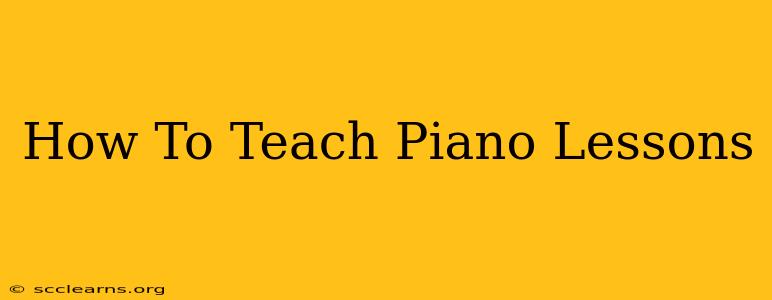So, you're passionate about piano and want to share that passion by teaching others? That's fantastic! Teaching piano lessons can be incredibly rewarding, but it requires more than just playing the instrument well. This comprehensive guide will walk you through everything you need to know to become a successful and effective piano teacher.
I. Before You Start Teaching: Laying the Foundation
Before you even think about your first student, you need a solid foundation. This includes:
A. Assessing Your Skills and Knowledge
- Technical Proficiency: Are you truly comfortable playing a wide range of musical styles and levels of difficulty? Honest self-assessment is key. Consider taking advanced lessons yourself to refine your technique and expand your repertoire.
- Musical Theory Understanding: A strong grasp of music theory is essential for explaining musical concepts to students. This includes understanding scales, chords, rhythm, harmony, and music notation. If your theory is rusty, brush up!
- Pedagogical Approach: How will you teach? What methods resonate with you? Research different teaching methodologies (e.g., Suzuki, Kodály, etc.) to find an approach that suits your style and your students' needs.
B. Creating a Suitable Learning Environment
- Dedicated Space: Designate a quiet, well-lit space specifically for piano lessons. Minimize distractions.
- Proper Equipment: Ensure you have a well-maintained piano or keyboard in good working order. A good quality instrument significantly impacts the learning experience.
- Materials and Resources: Gather essential teaching materials like method books, sheet music, music theory workbooks, and any supplementary resources you plan to use.
II. Finding and Attracting Students
Getting your first students might seem daunting, but several strategies can help:
A. Networking and Marketing
- Word-of-Mouth: Let your friends, family, and community know you're offering lessons.
- Online Presence: Create a simple website or social media profile showcasing your teaching experience and expertise. Use relevant keywords like "piano lessons," "piano teacher," "[your city] piano lessons," etc., for better search engine visibility.
- Local Connections: Connect with local music schools, community centers, and libraries. They might be able to refer students to you.
- Online Platforms: Consider listing your services on platforms dedicated to connecting teachers with students.
B. Setting Your Rates and Policies
- Competitive Pricing: Research the average rates for piano teachers in your area to determine a fair price.
- Clear Policies: Establish clear policies regarding lesson cancellations, payment methods, and student expectations. A well-defined contract can prevent misunderstandings.
III. Effective Piano Teaching Techniques
This is the heart of it all. How do you actually teach?
A. Building a Strong Student-Teacher Relationship
- Positive Reinforcement: Focus on students' progress and celebrate their achievements. Positive feedback boosts confidence and motivation.
- Patience and Understanding: Learning takes time and effort. Be patient and understanding, adapting your teaching style to each student's learning pace and personality.
- Clear Communication: Communicate your expectations clearly, provide constructive criticism, and actively listen to your students' concerns.
B. Structuring Effective Lessons
- Lesson Planning: Plan your lessons in advance. Outline specific goals, activities, and exercises for each session.
- Progressive Curriculum: Gradually introduce new concepts and techniques, building upon previously learned skills.
- Variety of Activities: Incorporate different learning activities, including playing, singing, music theory exercises, and games, to keep students engaged.
- Regular Assessments: Regularly assess your students' progress to identify areas that need more attention.
C. Addressing Common Challenges
- Student Motivation: Keep students motivated by setting achievable goals, providing positive reinforcement, and making lessons fun and engaging.
- Technical Difficulties: Address technical challenges patiently, breaking down complex techniques into smaller, manageable steps.
- Musicality and Expression: Encourage students to develop their musicality and expressive skills by exploring dynamics, phrasing, and articulation.
IV. Continuous Improvement
Teaching is a journey of continuous learning. Embrace professional development opportunities, stay updated with new teaching methodologies, and constantly reflect on your teaching practices to improve your effectiveness.
By following these steps, you'll be well on your way to becoming a successful and impactful piano teacher, leaving a lasting positive impression on your students and enriching their lives through the beautiful art of music. Remember, patience, passion, and a genuine desire to help others learn are invaluable assets in this rewarding profession.

